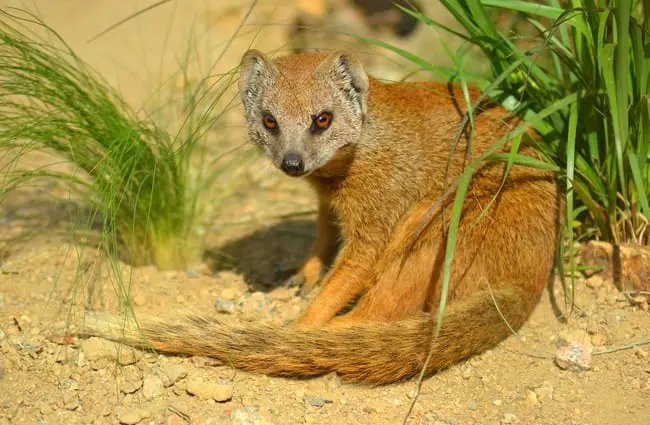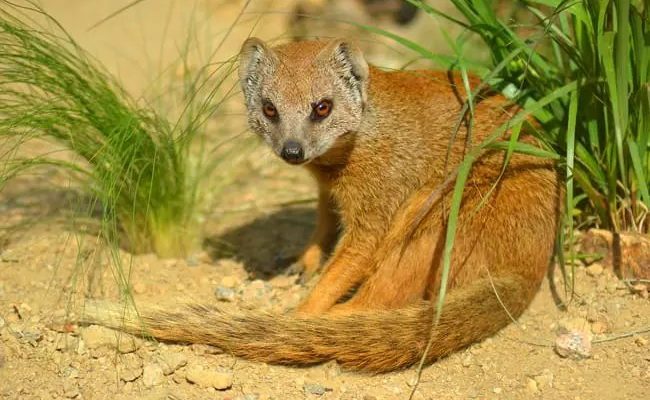
It’s like looking at a big family photo—you see some traits passed down through the generations, but each member has their own unique flare. Just as cousins might share similar features, these animals exhibit characteristics that can confuse even the keenest of observers. With a mix of mustelids, mammals, and even some smaller carnivores, you might find yourself fascinated by the diversity of life out there. So, grab a cup of coffee and let’s dive into the 10 animals that resemble our friend, the yellow mongoose!
1. Mongooses
Mongooses, including the **common mongoose**, are perhaps the closest relatives to the yellow mongoose. These small carnivores, found in Africa and parts of Asia, have a similar slender body and short legs. One of their standout features is their adaptable nature, which allows them to thrive in a variety of habitats—from dry savannas to forests.
**How to Tell Them Apart:** While mongooses often have a similar color palette, the yellow mongoose has a more distinctly yellow fur. If you compare fur texture, you’ll notice the yellow mongoose has a finer coat, whereas the common mongoose tends to be coarser. Additionally, mongooses often have a more varied diet, which includes insects, fruits, and even small reptiles.
2. Meerkats
Meerkats are another critically acclaimed member of the mongoose family. They’re known for their upright stance, a behavior often seen when they’re on lookout for predators. These social animals live in large clans and are famous for their cooperative hunting tactics.
**How to Tell Them Apart:** You might confuse a meerkat with a yellow mongoose at first glance due to their similar builds. However, meerkats have a more elongated face and larger eyes, adapting them for spotting threats from a distance. Their cohabitation habits and vocalizations are unique, usually engaging in a chatter that is distinct from the solitary nature of the yellow mongoose.
3. Civets
Civets are fascinating creatures often found in tropical forests. They’re not closely related to the yellow mongoose, but they can share a similar body shape and size. Civets also have distinctive markings and longer snouts, lending them a slightly different appearance.
**How to Tell Them Apart:** While both animals might have similar sizes, civets usually have a more patterned coat and a longer, thinner build. The yellow mongoose has a more robust body and a solid color, making them easier to identify when you look closely.
4. African Wild Cat
The African wild cat is a smaller feline that roams across Africa. With their own unique coat patterns, they share the environment with yellow mongooses, which may lead to some confusion in the wild.
**How to Tell Them Apart:** Despite their similar habitats, you can distinguish them by their tails. The yellow mongoose has a bushier tail, while the African wild cat sports a long, slender tail. In terms of behavior, wild cats tend to be more solitary, while mongooses often socialize in groups.
5. Foxes
Though not directly similar, some species of foxes, such as the fennec fox, have comparable physical traits. This small, desert-dwelling fox has large ears and a bushy tail, sharing the yellow mongoose’s adaptability to arid environments.
**How to Tell Them Apart:** The key difference lies in their size and ear structure. Fennec foxes have much larger ears relative to their body size, which help dissipate heat. The yellow mongoose doesn’t possess such prominent features, and their ears are smaller and more rounded.
6. Ferrets
Ferrets are domesticated relatives of the mongoose family, and while they share a playful demeanor and a similar elongated body, they are distinctly different in habitat and behavior.
**How to Tell Them Apart:** Ferrets are typically smaller and have a more varied coat color, ranging from white to black, with various patterns. The yellow mongoose will almost always have that rich yellow hue. Additionally, ferrets are quite social and live with humans, while yellow mongooses thrive in wild colonies.
7. Badgers
Badgers are another animal that can sometimes be mistaken for a yellow mongoose due to their similar body shapes. With their stout bodies and short legs, they can look somewhat alike at first glance.
**How to Tell Them Apart:** Badgers have a stockier build and an unmistakable facial marking—often a white stripe running from the nose to the back of the head. In contrast, the yellow mongoose’s face is uniformly colored, making them rather easy to tell apart once you get familiar with their features.
8. Dwarf Mongooses
Dwarf mongooses are the smallest of the mongoose family and can be mistaken for juvenile yellow mongooses. These tiny creatures are social and often live in groups, which makes them quite charming.
**How to Tell Them Apart:** The main differentiator here is size. Dwarf mongooses are significantly smaller and have a more compact body. Their playful, energetic nature also sets them apart from the more solitary yellow mongoose.
9. Ground Squirrels
Ground squirrels inhabit similar environments and can share some physical attributes with yellow mongooses, especially in regions where both species thrive.
**How to Tell Them Apart:** Although they are similar in size, ground squirrels typically have a more robust body and bushy tails, along with a distinctive pattern of fur that can include stripes. The yellow mongoose, in contrast, has a sleek fur appearance and a more uniform color.
10. Weasels
Weasels might seem like distant cousins to the yellow mongoose. They have a similar body shape and are also small carnivores. Found in various regions, these creatures can sometimes share habitats, leading to potential confusion in the wild.
**How to Tell Them Apart:** Weasels generally have a much slimmer body and longer necks, giving them a sleeker appearance. Their fur can also differ widely in color, ranging from brown to white, while the yellow mongoose maintains its bright yellow color throughout the seasons.
In conclusion, the animal kingdom is full of fascinating creatures, each with unique traits and behaviors. The yellow mongoose stands out, but so do its relatives and look-alikes. Understanding how to tell these animals apart not only enhances your appreciation for wildlife but also helps protect their habitats. Whether you’re an aspiring nature enthusiast or just curious, knowing the differences among these animals can deepen your connection to the natural world. Happy exploring!

